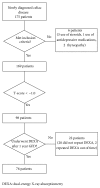Bone mineral density at diagnosis of celiac disease and after 1 year of gluten-free diet
- PMID: 25379519
- PMCID: PMC4213989
- DOI: 10.1155/2014/173082
Bone mineral density at diagnosis of celiac disease and after 1 year of gluten-free diet
Abstract
Atypical or silent celiac disease may go undiagnosed for many years and can frequently lead to loss of bone mineral density, with evolution to osteopenia or osteoporosis. The prevalence of the latter conditions, in case of new diagnosis of celiac disease, has been evaluated in many studies but, due to the variability of epidemiologic data and patient features, the results are contradictory. The aim of this study was to evaluate bone mineral density by dual-energy X-ray absorptiometry in 175 consecutive celiac patients at time of diagnosis (169 per-protocol, 23 males, 146 females; average age 38.9 years). Dual-energy X-ray absorptiometry was repeated after 1 year of gluten-free diet in those with T-score value <-1 at diagnosis. Stratification of patients according to sex and age showed a higher prevalence of low bone mineral density in men older than 30 years and in women of all ages. A 1-year gluten-free diet led to a significant improvement in lumbar spine and femoral neck mean T-score value. We propose that dual-energy X-ray absorptiometry should be performed at diagnosis of celiac disease in all women and in male aged >30 years, taking into account each risk factor in single patients.
Figures
References
-
- Ribaldone D. G., Astegiano M., Fagoonee S., Rizzetto M., Pellicano R. Epilepsy and celiac disease. Panminerva Medica. 2011;53(4):213–216. - PubMed
-
- Dubé C., Rostom A., Sy R., Cranney A., Saloojee N., Garritty C., Sampson M., Zhang L., Yazdi F., Mamaladze V., Pan I., Macneil J., Mack D., Patel D., Moher D. The prevalence of celiac disease in average-risk and at-risk Western European populations: a systematic review. Gastroenterology. 2005;128(4, supplement 1):S57–S67. doi: 10.1053/j.gastro.2005.02.014. - DOI - PubMed
MeSH terms
LinkOut - more resources
Full Text Sources
Other Literature Sources
Medical




